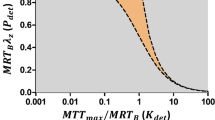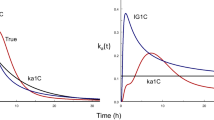Abstract
The many limitations in determining the pharmacokinetic parameters of firstorder invasion of, and elimination from, the onecompartment body model by the method of residuals or by “feathering” Ct data can be minimized by applying the simplified methods outlined herein. Comparisons of the apparent volumes of distribution, V, calculated on the premises that the Bateman Function represents ka>ke or its converse, ke>ka,i.e., flip-flop, can permit a proper choice of the correct version. Estimation of ke can be obtained by regression of (A0/V)/C(oncentration) on AUC1/ Cwhere A0/Vis estimable from knowledge of Cmax and tmax since \(A_0 /V = C_{max} e^{k_e t_{max} }\).The ratio of the magnitude of the rate constant of invasion to that of elimination, m=ka/ke,is related to ketmax by the expression ketmax=ln m/ (m−1)for all possible values of m.A table for the determination of m from values of ketmax is given. When bioavailability, γ=A0/Dose,is known or complete, ke and Vcan be determined from the respective ordinate and abscissa of the intersection of \(A_0 /C_{max} e^{k_e t_{max} }\) and Cl(clearance)/ke,both plotted against arbitrary ke values. The two functions may not intersect at low values of mdue to errored C-t values but the ke value when the two curves are closest (kmin)may approximate ke.The intersections of \(C_{max} e^{k_e t_{max} }\) and keAUCT (AUCtrap)plotted against variable ke values (Method A) provide estimates of ke from their abscissa values and A/Vfrom their ordinate values when γis unknown. Method B appears to give more reliable estimates of ke at the kmin of the difference \(e^{k_e t_{max} } /k_e - AUCT/C_{max}\) plotted against ke.Since kmin of this plot is 1/tmax when m=1,the identity of the mas unity underlying the C-t data is indicated when either kmintmax is approximately unity or kmin ispractically synonymous with 1/tmax.This was clearly shown when 12 constructed m=1,C-t cases with 10% random error were evaluated by Method B. Better estimates were effected by all procedures when the raw C-t data were smoothed.
Similar content being viewed by others
References
D. S. Riggs.The Mathematical Approach to Physiological Problems. A Critical Primer, Williams and Wilkins, Baltimore, MD, 1963, pp. 120–162,
D. S. Riggs.The Mathematical Approach to Physiological Problems. A Critical Primer, Williams and Wilkins, Baltimore, MD, 1963, p. 163.
M. Gibaldi and D. Perner.Pharmacokinetics, Marcel Dekker, New York, 1975, pp. 281–292, pp. 33–34.
M. Gibaldi and D. Perner.Pharmacokinetics, Marcel Dekker, New York, 1975, p. 18, pp. 33–34.
M. Gibaldi and D. Perrier.Pharmacokinetics, 2nd ed. Marcel Dekker, New York, 1982, pp. 433–436
M. Gibaldi and D. Perrier.Pharmacokinetics, 2nd ed. Marcel Dekker, New York, 1982, pp. 145–198
M. Gibaldi and D. Perrier.Pharmacokinetics, 2nd ed. Marcel Dekker, New York, 1982, pp. 34–39
M. Gibaldi and D. Perrier.Pharmacokinetics, 2nd ed. Marcel Dekker, New York, 1982, p. 18
M. Gibaldi and D. Perrier.Pharmacokinetics, 2nd ed. Marcel Dekker, New York, 1982, pp. 409–417.
H. Bateman. The solution of a system of differential equations occurring in the theory of radioactive transformations.Proc. Cambridge Phil. Soc. 15:423–427 (1910).
F. H. Dost.Grundlagen der Pharmakokinetik, Georg Thieme Verlag, Stuttgart, 1968, pp. 44–47, 241–242;
F. H. Dost.Grundlagen der Pharmakokinetik, Georg Thieme Verlag, Stuttgart, 1968, p. 43.
S. Glasstone.Textbook of Physical Chemistry, 2nd ed. D. Van Nostrand Co., New York, 1946, pp. 1075–1077.
P. L. Altman and D. S. Dittmer (eds.).Biology Data Book, Federation of American Societies for Experimental Biology, Washington, DC, 1964, p. 264.
P. L. Altman and D. S. Dittmer (eds.).Blood and Other Body Fluids, Federation of American Societies for Experimental Biology, Washington, D.C., 1961, p. 358, (b) p. 5.
P. L. Altman and D. S. Dittmer (eds.).Blood and Other Body Fluids, Federation of American Societies for Experimental Biology, Washington, D.C., 1961, p. 5.
K. K. H. Chan and K. W. Miller. Nonlinear regression approach for determining whether absorption and elimination rate constants are equal in the one-compartment body model with first-order processes.J. Pharm. Sci. 72:574–576 (1983).
I. H. Patel. Concentration ratio method to determine the rate constant for the special case when ka = ke.J. Pharm. Sci. 73:859–861 (1984).
C. M. Metzler, G. K. Elfring, and A. J. McEwen. A package of computer programs for pharmacokinetic modelling.Biometrics 30:562–563 (abstr.) (1974).
K. Yamaoka, Y. Tanigawara, T. Nakagawa, and T. Uno. A pharmacokinetic analysis program (multi) for microcomputer.J. Pharm. Dyn. 41:879–885 (1981).
J. G. Wagner and E. Nelson. Kinetic analysis of blood levels and urinary excretion in the absorptive phase after single doses of drugs.J. Pharm. Sci. 53:1392–1403 (1964).
A. J. Sedman and J. G. Wagner.AUTOAN: a decision-making pharmacokinetic computer program. Publication Distribution Service, Ann Arbor, MI, 1974.
R-Strip & Minsq. Micromath Scientific Software, Salt Lake City, UT, 1987.
M. Bialer. A simple method for determining whether absorption and elimination rate constants are equal in the one-compartment open model with first-order processes.J. Pharmacokinet. Biopharm. 8:111–113 (1980).
J. Zhi. Unique pharmacokinetic characteristics of the one compartment first order absorption model with equal absorption and elimination rate constants.J. Pharm. Sci. 79:652–654 (1990).
M. Barzegar-Jalai and M. Toomanian, Theoretical consideration from the cases where absorption rate constant approaches elimination rate constant in the linear one-compartment open models.Int. J. Pharm. 12:351–354 (1982).
P. Macheris, M. Symillides, and C. Reppas. On the assessment of the relative magnitude of rate constants in the linear open one-compartment model.J. Pharm. Sci. 81:1231–1233 (1992).
D. Perrier and M. Mayersohn, Non compartmental determination of the steady state volume of distribution for any mode of administration.J. Pharm. Sci.,71:373–373 (1982).
E. R. Garrett, Integral procedures in pharmacokinetics and their application to the parameter determination of appearing metabolites in L. Z. Benet, G. Levy, and B. L. Ferraiolo (eds.),Pharmacokinetics A Modern View, Plenum Press, New York, 1984, pp. 253–279.
E. R. Garrett, Pharmacokinetic procedures and strategies. In E. R. Garrett and J. L. Hirtz (eds.),Drug Fate and Metabolis Methods and Techniques, Vol. 5, Marcel Dekker, New York, 1985, pp. 1–49.
K. Yamaoka, T. Nakagawa, and T. Uno. Statistical moments in pharmacokinetics.J. Pharmacokin. Biopharm. 6:547–558 (1978).
Author information
Authors and Affiliations
Additional information
We regretfully announce that Dr. Edward Garrett passed away on October 25, 1993, after an extended illness.
An erratum to this article is available at http://dx.doi.org/10.1007/BF02353543.
Rights and permissions
About this article
Cite this article
Garrett, E.R. Simplified methods for the evaluation of the parameters of the time course of plasma concentration in the one-compartment body model with first-order invasion and first-order drug elimination including methods for ascertaining when such rate constants are equal. Journal of Pharmacokinetics and Biopharmaceutics 21, 689–734 (1993). https://doi.org/10.1007/BF01113501
Received:
Revised:
Published:
Issue Date:
DOI: https://doi.org/10.1007/BF01113501




